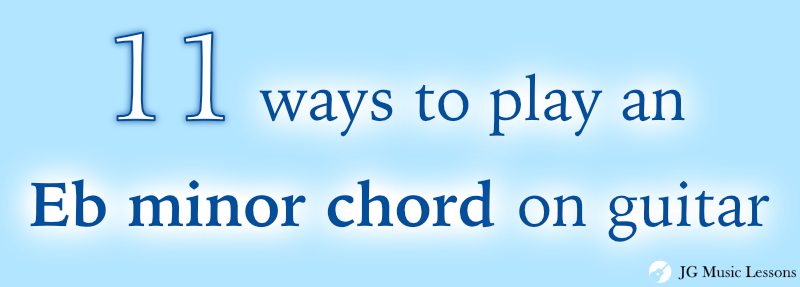The Eb minor chord is a less commonly known chord when first learning to play guitar. The lowercase ‘b’ represents a flat, meaning the note indicated is lowered by a half step.
If you look up how to play an Eb minor chord (E flat minor), this might come up as a barre chord on the 6th fret, starting on the 5th string. This can be a difficult chord for a beginner but there are many different ways you can play this chord on the guitar.
This lesson covers 11 ways to play an Eb minor chord on guitar which you can start to incorporate to your playing. Grab your guitar and let’s get started!
Eb minor chord theory
Let’s first look at some basic theory to understand this chord.
Minor triad chords are built on the chord tones 1, b3, and 5. These chord tones can also be thought of as the scale degrees related to one minor scale.
For example, the Eb minor chord has the notes Eb, Gb, and Bb.
Here is the formula for minor chords below.
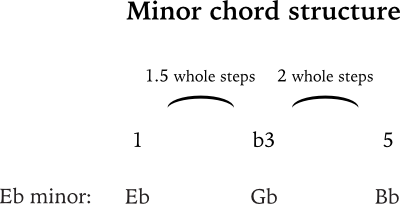
In contrast, Major triad chords contain the chord tones 1, 3, and 5. For example, an Eb Major chord has the notes Eb, G, and Bb. However, we will only be covering the different minor chord variations in this lesson.
Now that you know what notes belong to the chord structure let’s look at how to read the chord charts.
How to read the chord charts
For the charts below:
- The top horizontal line of the chord chart represents the high E string and the bottom horizontal line represents the low E string.
- The vertical lines separate each fret.
- The numbers in the blue dots tell you which fingers to use on the fretting hand.
- The letters on the right of the charts tell you what notes you are playing on each string.
- Circles on the left represent open strings.
- Red X means to avoid that string.
You can check this link for more on how to read guitar notation symbols.
Eb minor triad chord
A simple way you can play an Eb minor chord is by using the following triad shape.
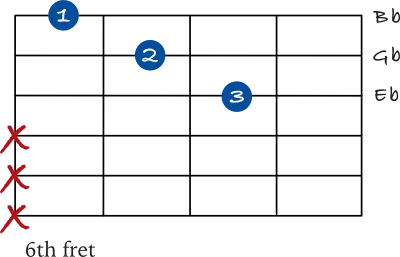
Eb minor triad including pinky
You can also add your pinky finger to the previous shape to make the chord sound fuller like this:
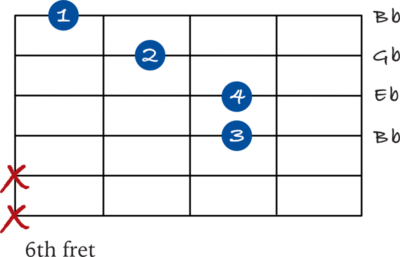
Eb minor chord on the 5th string (without a barre)
Similar to the previous shape, this time we are adding the first finger on the 5th string, 6th fret. We’re gradually building upon the previous chords before we get to barre chords. The shape looks like this:
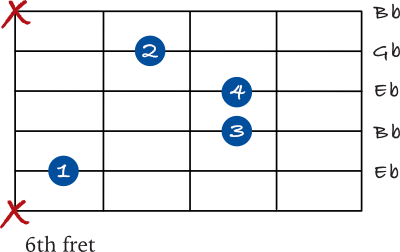
Eb minor chord barre on the 5th string
This is probably the most common chord shape that will show up when looking up an Eb minor chord. This shape comes from the open A minor chord except you have to rearrange your fingers as you barre the 6th fret with your 1st finger.
If you can’t get the note on the 1st string to sound clear, you can play this chord without the barre and only play the notes from the 5th to the 2nd string (as shown in the previous chart). Then, you can come back to this chord shape as you develop more strength in your fretting hand.
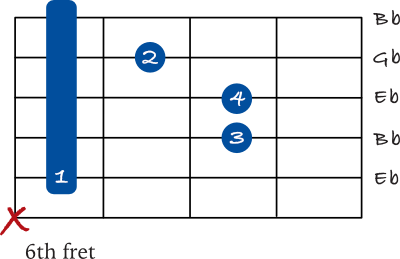
Tip* If this chord is still difficult to play, start the shape higher up on the fretboard. The tension of the strings is lighter as you press down on chords higher up the fretboard. Then you can gradually shift the shape down as you develop more strength in your hand.
If needed, check out these 5 tips to get better at playing barre chords on guitar.
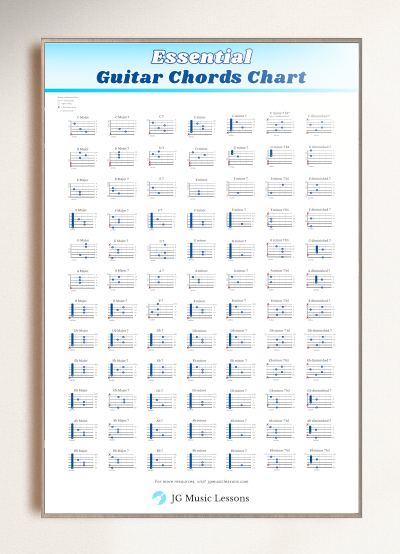
Eb minor chord on the 4th string
This shape comes from the open D minor chord except you have to rearrange your fingers as you add your 1st finger. This shape can feel uncomfortable when first learning it but you will get better at it as you keep reviewing it.
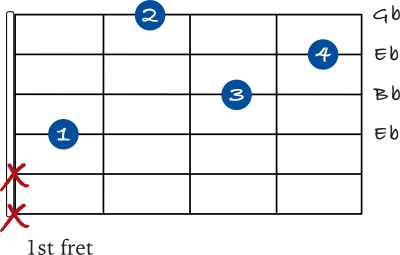
Eb minor mini barre chord, starting on the 4th string
Another way you can play this chord is by using a mini barre or half barre on the 11th fret. If some notes sound unclear, you could first try playing the barre on the top strings with your 1st finger and then try it again after placing your third finger on the 4th string.
The shape looks like this:
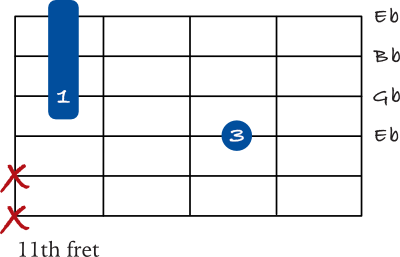
Eb minor mini barre chord (Eb min/Bb)
This is an Eb minor chord in 2nd inversion which means that the 5th degree of the chord is in the bass. This makes the chord sound fuller compared to the last chord we looked at. You can play it like this:
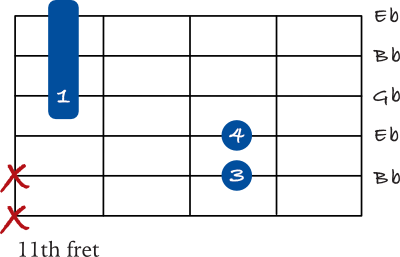
You can also check out this other lesson for more on how to play chord inversions on the guitar.
Eb minor barre chord on the 6th string
At this point, we’ve worked on different steps to take before getting to this chord because it requires more strength in your fretting hand.
This shape comes from the open E minor chord except you have to rearrange your fingers as you barre the 11th fret with your 1st finger like this:
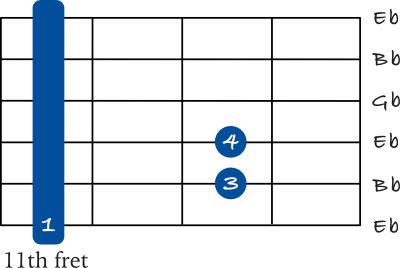
Eb minor chord spread shapes
The following chords are called spread shapes because of the wider space between some of the notes within the chord shape. Because these chord shapes skip a string, they are more suitable for a finger picking style of playing. You might also hear these chords in a more classical music context.
To go more in-depth, check out this lesson on how to play spread triad chords on guitar.
Eb minor spread chord on the 6th string

Eb minor spread chord on the 5th string
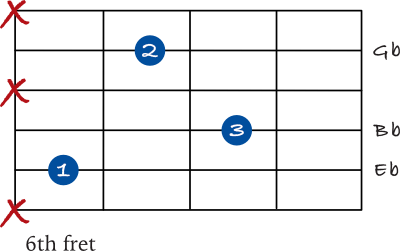
Eb spread chord on the 4th string
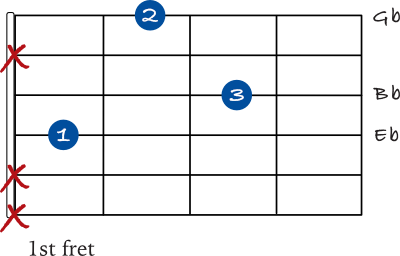
Wrapping up
All these chords were mostly in root position, meaning the root note is in the bass. However, you certainly have more variations if you use different chord inversions. This is when you play a chord with notes other than the root.
It’s good to know many possibilities of playing the same chord because you have more flexibility to move around the fretboard. Also, you can use different chord variations when you need a certain note at the top to help define a melody that you are playing over.
I hope this helped you understand how to play an Eb minor guitar chord or learn new ways of playing it. You can also try shifting these shapes to play other minor chords on the same string.
📘 Get the free guitar practice guide here!
All the best,
JG Music Lessons
📙 Kickstart your guitar playing with our step by step guide: Guitar Essentials.
🎸 Looking for a travel or half-sized guitar? See this one.
🛠 See our other music recommendations.
🤝 Support the site to help us to create better content for you!
Level up with the FREE guitar practice guide and effectively improve your playing! 🎸
Get it sent to your email!

